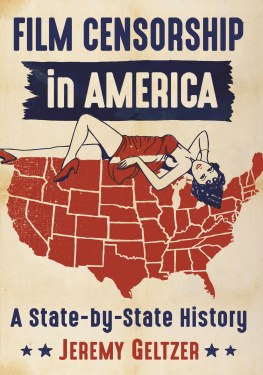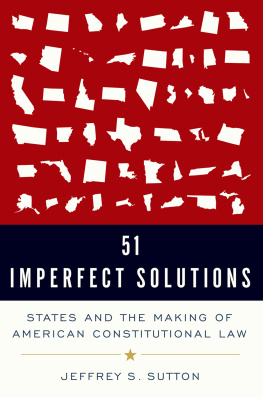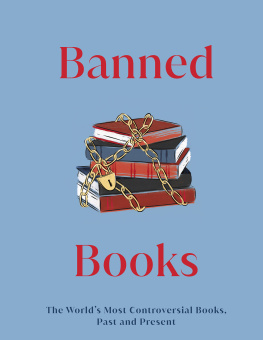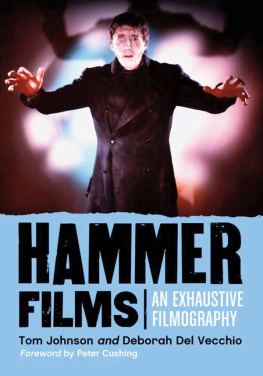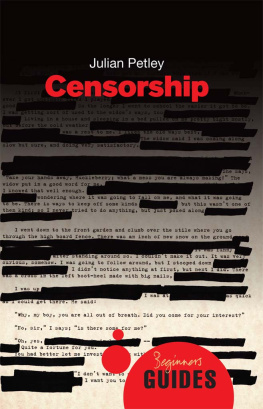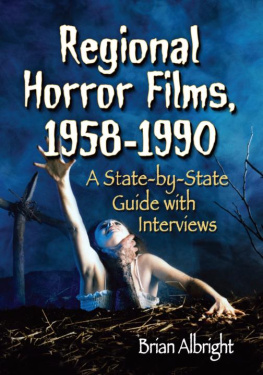
Film Censorship in America
A State-by-State History
JEREMY GELTZER

McFarland & Company, Inc., Publishers
Jefferson, North Carolina
LIBRARY OF CONGRESS CATALOGUING DATA ARE AVAILABLE
BRITISH LIBRARY CATALOGUING DATA ARE AVAILABLE
e-ISBN: 978-1-4766-3012-0
2017 Jeremy Geltzer. All rights reserved
No part of this book may be reproduced or transmitted in any form or by any means, electronic or mechanical, including photocopying or recording, or by any information storage and retrieval system, without permission in writing from the publisher.
Front cover: Poster art for the 1936 film Marihuana (Roadshow Attractions)
McFarland & Company, Inc., Publishers
Box 611, Jefferson, North Carolina 28640
www.mcfarlandpub.com
Acknowledgments
To my wife Heather, who provides encouragement, support, optimism, and endless strength, beauty, and poise. And Jackson, my son and best friend, full of curiosity and eager to learn, your intense energy is an inspiration. I could never have written this book without you both.
From my earliest memory my family has always nurtured a deep love of movies, media, and debate. Ranging the spectrum from Bogie to Bunuel, conversations with Mom, Dad and Gabe always flow with insightand provided the foundation for my scholarship.
This book demonstrates that across America everyone loves the movies. While films entertain us, regional censors have strived to silence unpopular, controversial, risqu, and challenging voices. Free speech is a powerful right but it is vulnerable and must be protected.
We dont have to give our reasons.
Memphis censor Lloyd T. Binford on banning
Charlie Chaplins Monsieur Verdoux
Introduction
Motion pictures flickered to life in 1891. Edisons first viewing device, the Kinetoscope, sold for $300about $7,500 today. As early spectators peered into the peephole projector they were drawn into a hypnotic world of images in action. Scenes of dancers twirling, boxers sparring, and musclemen flexing shimmered by. These enticing images and visions of light announced the coming era of mass media and electronic entertainment.
An updated generation of picture devicesnow projecting images on a screenleft Edisons laboratory in 1896. As the rebranded Vitascope began generating revenue, an ecosystem emerged around the new medium and experimenting engineers gave way to a corporate structure of producers, distributors, exhibitors, and executives. By 1905 amusement parlors teemed with eager audiences. Young people and women found a safe space to gather in the picture arcade. Working-class folks appreciated the cheap nickel-and-dime entertainment. Immigrants saw silent photoplays as an informative illustrated primer on living in America. Motion pictures such as President McKinleys Inauguration (1901), A Trip to the Moon (1902), The Great Train Robbery (1903), and Opening Ceremonies, St. Louis Exposition (1904) thrilled and captivated, entertained and educated. The emerging technology had a unique ability to touch people on a personal, even spiritual level.
But not everyone loved the movies. Civic authorities felt threatened by the emergence of a mass media that took power and influence out of their hands and beyond their control. Women and children mingling with the working class and immigrants unsupervised in a darkened auditorium upset the social order. Some concerns bordered on the ridiculous. In 1910 John Holcend interrupted fellow audience members at a Brooklyn theater. Newspapers reported that ushers started to take [Holcend] out when he fell on the floor laughing. He was taken home still laughing and died several hours later still laughing hysterically. Other concerns were more reality-based than fears of death by laughter. Many of the pop-up film parlors were unlicensed, unregulated, and unsafe firetraps easily ignited by the highly flammable nitrate film stock. Perhaps the most troublesome issue was triggered by film content. Popular pictures often contained scenes considered inappropriate to a society still bound by the vestiges of Victorian values, Edwardian etiquette, and proper public behavior. Hip-shaking dancers risked arousing male viewers, stripped-down prizefighters exposed women to muscular male anatomy, off-color comedies lampooned authority figures, and voyeurism once improper was now commonplace.
As the film industry grew so did the mechanisms of state censorship. By the early 1920s the major film studios, Universal, Paramount, Fox, MGM, and Warner Bros., were well established in California and New York. Tracking with this expansion, film censor boards were convened throughout America. These moral authorities had the sworn duty to shield their communities from the moral corruption potentially posed by Hollywood movies.
Their names are forgotten today, but in their time film censors held sway over pop culture. Maj. Metellus Lucullus Cicero Funkhouser in Chicago, the Rev. Festus Foster in Kansas, and Dr. Ellis Paxson Oberholtzer in Pennsylvania were among the earliest. Lloyd T. Binford in Memphis, Christine Smith Gilliam in Atlanta, and Mary Avara in Baltimore were among the most outspoken and opinionated. Some regulators were vastly unqualified for their positions. In 1922 Ohio appointed the Rev. Wallace W. Foust as a state censor despite his own admission that he hadnt seen a film in five and a half yearsor perhaps ever. These state censors were not advisory; rather, they held actual legal authority to cut, edit, abridge, and even ban motion pictures before they ever reached their audiences. A film that ran in Philadelphia would be different in Peoria and Pasadena, and secondary markets like Pascagoula received the remnants of multiple rounds of censor cuts.
The decision of what material to excise from films could be arbitrary, unpredictable, and often based on the personal predilections of political appointees. Over time guidelines arose. The most forbidden elements included scenes of sensual kissing over three seconds in duration, nudity, birth control, abortion, drunkenness, drug use, prostitution, profanity, criminal modus operandi, and gunplay.
Cinema has always been provocative. From the moment the first motion pictures unspooled there has coexisted both an enthusiastic adoration of screen icons as well as a near-puritanical drive to control content. Over the past century moviemakers pushed cultural boundaries, empowered women, spoke out against fascism, wrestled with issues of race, and gave voice to troubled teens. State censors pushed back, dedicating their efforts to upholding conservative values, accepted conventions, and prudish decoruman old guard waging war against changing times.
Journeying from state to state and looking at the effects of local censors, a hidden history of regional cinemas comes to light. Forgotten film studios in Chicago, Fort Lee (NJ), Tallahassee, Providence, Austin, Chadron (NE), and Upper Priest Lake (ID) came to life. While anyone with a smartphone today has the ability to create content, the drive to tell personal stories has existed from the earliest days of filmmaking. Many of these filmmakers have become shrouded in mystery, obscured by time, and erased by the mainstream industry. Ironically, some of these lost films have been rediscovered in archives where they had been mothballed by censors of an earlier era. In seeking to eradicate content, the censors cuts could have an unintended consequence: the edits meant to erase content ending up saving it, storing scenes, preserving clips, and even protecting entire movies.
Next page
